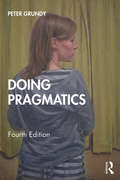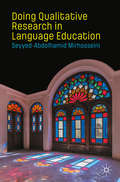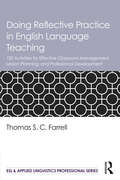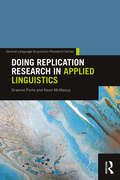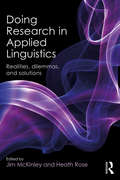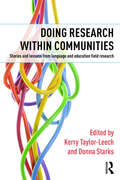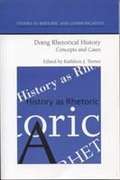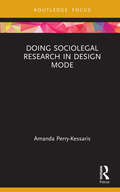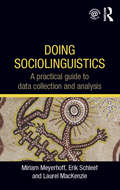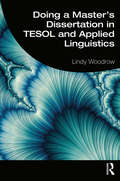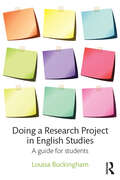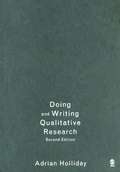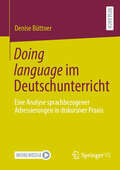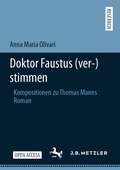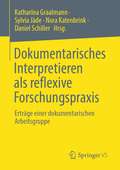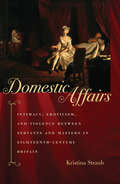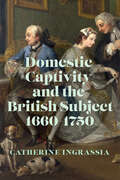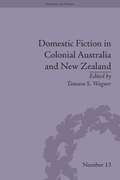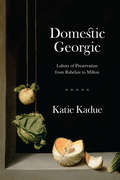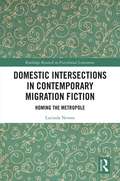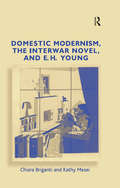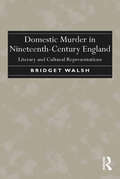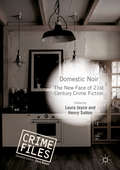- Table View
- List View
Doing Pragmatics
by Peter GrundyDoing Pragmatics is a popular reader-friendly introduction to pragmatics. Embracing the comprehensive and engaging style which characterized the previous editions, this fourth edition has been fully revised. Doing Pragmatics extends beyond theory to promote an applied understanding of empirical data and provides students with the opportunity to ‘do’ pragmatics themselves. A distinctive feature of this textbook is that virtually all the examples are taken from real world uses of language which reflect the emergent nature of communicative interaction. Peter Grundy consolidates the strengths of the original version, reinforcing its unique combination of theory and practice with new theory, exercises and up-to-date real data and examples. This book provides the ideal foundation for all those studying pragmatics within English language, linguistics and ELT/ TESOL.
Doing Qualitative Research in Language Education
by Seyyed-Abdolhamid MirhosseiniThis textbook provides a hands-on introduction for students embarking on their first qualitative research projects in language teaching and learning environments. The author addresses theoretical, methodological, and procedural aspects of conducting qualitative studies on issues of language teaching and learning, and includes examples which take a closer look at real-world scenarios and obstacles that might occur in language education research. Written in learner-friendly language, this textbook provides a rare how-to text for beginner qualitative researchers, and will be a valuable resource for upper undergraduate and postgraduate students on courses in applied linguistics, second/foreign language teaching, TESOL, literacy studies and related fields.
Doing Reflective Practice in English Language Teaching: 120 Activities for Effective Classroom Management, Lesson Planning, and Professional Development (ESL & Applied Linguistics Professional Series)
by Thomas S. FarrellThis practical and engaging book introduces readers to reflective practice in English language teaching. Assuming no background knowledge, Thomas S. C. Farrell clearly and accessibly walks through ways that teachers can integrate and implement reflective practice in the classroom and in other contexts to benefit their teaching and their own professional development. Each chapter covers an important dimension of reflective practice and features many ready-to-use activities that are designed to empower teachers and allow them to overcome challenges they’ll face throughout their careers. Covering many types of reflection and the many purposes it serves, this book addresses written reflection, lesson planning, classroom observation, classroom management, group communication and more. This resource is ideal for preservice and early career language teachers and is an important supplement to courses in language education and applied linguistics programs.
Doing Replication Research in Applied Linguistics (Second Language Acquisition Research Series)
by Graeme Porte Kevin McManusDoing Replication Research in Applied Linguistics is the only book available to specifically discuss the applied aspects of how to carry out replication studies in Applied Linguistics. This text takes the reader from seeking out a suitable study for replication, through deciding on the most valuable form of replication approach, to its execution, discussion, and writing up for publication. A step-by-step decision-making approach to the activities guides the reader through the replication research process from the initial search for a target study to replicate, through the setting up, execution, analysis, and dissemination of the finished work.
Doing Research in Applied Linguistics: Realities, dilemmas, and solutions
by Heath Rose Jim McKinleyDoing Research in Applied Linguistics: Realities, dilemmas, and solutions provides insight and guidance for those undertaking research, and shows the reader how to deal with the challenges of this research involving real people in real settings. Featuring over twenty chapters by experienced and up-and-coming researchers from around the world, this book: outlines the steps involved in solving the problem and completing a successful, and publishable, project; provides case studies of obstacles faced at each stage of research, from preliminary planning to report writing; addresses issues of validity and reliability during data collection and analysis; discusses ethical issues in research dealing with vulnerable groups including children, refugees, and students; includes examples from longitudinal studies, and both qualitative and quantitative research. Doing Research in Applied Linguistics is essential reading for students studying research methods, or for those embarking on their first research project in applied linguistics or language education.
Doing Research within Communities: Stories and lessons from language and education field research
by Kerry Taylor-Leech Donna StarksDoing Research within Communities provides real-life examples of field research projects in language and education, offering an overview of research processes and solutions to the common challenges faced by researchers in the field. This unique book contains personal research narratives from sixteen different and varied fieldwork projects, providing advice and guidance to the reader through example rather than instruction and enabling the reader to discover connections with the storyteller and gain insights into their own research journey. This book: provides advice, practical guidance and support for engaging with a community as a research site; covers the real-life theoretical, ethical and practical issues faced by researchers, such as language choice in multilingual communities, and the insider/outsider status of the researcher; discusses challenges posed by a variety of mono- and multilingual settings, from remote island communities to large urban areas; includes research from across the Asia-Pacific area, including Australia, New Zealand and East Timor, and also the US. Doing Research within Communities is essential reading for early career researchers and graduate students undertaking fieldwork within communities.
Doing Rhetorical History: Concepts and Cases
by Kathleen J. TurnerThis collection argues that rhetorical history, both as a methodology and as a perspective, offers insights that are central to the study of communication and unavailable through other approaches. The conceptualizations and methodologies of rhetorical history will increase in significance during the burgeoning "Communication Age" as we seek to cope with the present and prepare for the future by better understanding the past. This volume serves as an overview of a recently neglected methodological approach and acts as the first step in ending that neglect.
Doing Sociolegal Research in Design Mode
by Amanda Perry-KessarisThis book is the first to explore what design can do for sociolegal research. It argues that designerly ways—mindsets that are practical, critical and imaginative, experimental processes and visible and tangible communication strategies—can be combined to generate potentially enabling ecosystems; and that within these ecosystems the abilities of a researcher to make meaningful contributions and to engage in meaningful research relations, both within our research community and in the wider world, can be enhanced. It is grounded in richly illustrated examples of sociolegal researchers working in design mode, including original individual and collaborative experiments involving a total of over 200 researchers; and of experts from subfields such as social design, policy design, and speculative design working on issues of sociolegal concern. It closes with an opening: a set of accessible sociolegal design briefs on which the impatient can make an immediate start. Written by an experienced sociolegal researcher with formal training in graphic design, the book is primarily focused on what the sociolegal research community can take from design, but it also offers lessons to designers, especially those who work with law.
Doing Sociolinguistics: A practical guide to data collection and analysis
by Miriam Meyerhoff Erik Schleef Laurel MacKenzieDoing Sociolinguistics: A practical guide to data collection and analysis provides an accessible introduction and guide to the methods of data collection and analysis in the field of sociolinguistics. It offers students the opportunity to engage directly with some of the foundational and more innovative work being done in the quantitative or variationist paradigm. Divided into sixteen short chapters, Doing Sociolinguistics: can be used as a core text in class or as an easy reference whilst undertaking research walks readers through the different phases of a sociolinguistic project, providing all the knowledge and skills students will need to conduct their own analyses of language features excerpts from key research articles; exercises with real data from the authors’ own research; sample answers to the exercises; and further reading is supported by the Routledge Sociolinguistics Companion website (www.routledge.com/textbooks/meyerhoff) which features further online exercises with sound files. Designed to function as both a core text for methods classes in sociolinguistics and as a companion to the Routledge textbook Introducing Sociolinguistics, this book will be essential reading for all students studying and researching in this area.
Doing a Master's Dissertation in TESOL and Applied Linguistics
by Lindy WoodrowDoing a Master’s Dissertation in TESOL and Applied Linguistics is a practical guide for master’s students tackling research and research writing for the first time. Structured for use in class or as part of an independent study, and divided into the four stages of designing, researching, writing up and submitting a dissertation, this book: carefully guides readers from the very beginning of producing a research proposal, all the way through to assessment procedures and the provisions for resubmission; covers publishing your dissertation and applying for higher research degrees, including funding; addresses all the most fundamental concerns students have about master’s dissertations, including how to choose a topic and conducting a literature review; draws upon examples from master’s dissertations from the UK, US and Australia and provides numerous ‘how-to’ tables and checklists; and includes activities and resources to facilitate master’s research and dissertation writing, as well as FAQs and solutions at the end of each chapter. Tailormade for MA students in TESOL or Applied Linguistics, this book is essential reading for students on these degrees around the world as well as for their supervisors and programme directors.
Doing a Research Project in English Studies: A guide for students
by Louisa BuckinghamDoing a Research Project in English Studies is the essential guide to undertaking research and developing academic English literacy skills for students new to research. With a particular focus on the needs of students in contexts where English is used as a foreign or an additional language, this accessible textbook takes the reader through the research process in five main sections: getting started (arriving at a topic, interacting with a supervisor); finding bibliographic resources; collecting data; developing academic writing skills; preparing for the oral defence. Each chapter contains exercises; the answer key facilitates independent study throughout. Extracts from published research articles provide invaluable illustration of the features of academic writing. This is a must-have resource for advanced undergraduate and postgraduate students embarking on a research project in English studies.
Doing and Writing Qualitative Research (2nd edition)
by Adrian HollidayThis edition expertly tackles the practical problems which writers face when they attempt to transfer the rich data experience of their real world research into a textual product. New attention is paid to the crucial issues of the nature and use of visual data, personal narrative, core and periphery data, and data reconstruction and fictionalization.
Doing language im Deutschunterricht: Eine Analyse sprachbezogener Adressierungen in diskursiver Praxis
by Denise BüttnerDie Studie leistet einen empirisch-rekonstruktiven Beitrag zu einer machtkritisch ausgerichteten Fachdidaktik. Sie fokussiert den Deutschunterricht und die darin stattfindenden Interaktionen als diskursive Praxis, in der ein spezifisches Wissen in, über und angesichts von Sprache relevant gemacht wird. Für Subjektivierung ist jenes Wissen hochgradig wirkmächtig und bleibt den Akteur*innen im Prozess der schulischen Enkulturation doch größtenteils unbewusst. Darin liegt ein hohes Potential für die institutionelle (Re-)Produktion von Linguizismus.Vor diesem Hintergrund eröffnet die Studie einen Blick auf sprachbezogene Adressierungen, die in charakteristischer Weise vom Fach selbst ausgehen. Sie werden in (fach)didaktischen und pädagogischen Programmatiken breit kommuniziert und zeichnen sich bis auf die Ebene unterrichtlicher Praktiken ab. Um das Zusammenspiel von fachspezifischer Adressierung und Praktiken des ‚doing language‘ möglichst eng aufeinander beziehen und in rekonstruktionslogisch plausibilisierte Zusammenhänge bringen zu können, liegt der Arbeit ein wissenssoziologisch-diskursanalytischer Ansatz zugrunde.
Doktor Faustus (ver-)stimmen: Kompositionen zu Thomas Manns Roman
by Anna Maria OlivariIn diesem Open-Access-Buch widmet sich Anna Maria Olivari der Forschungslücke der Vertonung von Thomas Manns Doktor Faustus. Sie untersucht ein Korpus von 13 unterschiedlichen Kompositionen aus dem Bereich der Neuen Musik (Opern, Monodramen, instrumentale Werke), die zwischen 1952 und 2011 entstanden sind und bisher wenig bis gar nicht rezipiert wurden. Thomas Manns Doktor Faustus ist in vielerlei Hinsicht ein breit erforschtes Werk, jedoch nicht in Bezug auf seine Vertonungen. Der Vergleich zwischen Roman und Komposition ist im Forschungsparadigma der Intermedialität angesiedelt und ermöglicht die Rekonstruktion der kompositorischen Rezeptionsgeschichte von Doktor Faustus. Die Rückkopplungseffekte zwischen Text und Musik lassen Thomas Manns Roman neu lesen.
Dokumentarisches Interpretieren als reflexive Forschungspraxis: Erträge einer dokumentarischen Arbeitsgruppe
by Katharina Graalmann Sylvia Jäde Nora Katenbrink Daniel SchillerDer Sammelband fokussiert im ersten Teil Genese und Funktion der Arbeitsgruppe Dokumentarische Methode (AG DM), die Elemente einer Forschungswerkstatt und Interpretationsgruppe ineinander vereint. Dabei geht es neben Aspekten „klassischer“ Interpretationspraxis vor allem auch um Fragen der Aushandlung geteilter Grundannahmen im methodologischen Denken und Analysieren. Der zweite Teil speist sich aus methodologisch-methodischen Einzelbeiträgen rund um die Dokumentarische Methode, deren jeweilige Problemstellungen aus dem kollektiven Austausch innerhalb der AG DM resultierten. Damit leistet das Buch nicht nur einen Beitrag zum methodologischen-methodischen Diskurs, sondern hebt anhand handfester Beispiele den Mehrwert von einschlägigen qualitativen Arbeitsgruppen hervor.
Dolor y gloria
by Pedro AlmodóvarLa película más personal de Pedro Almodóvar. El libro más repleto de extras. Salvador Mallo es un veterano director de cine aquejado de múltiples dolencias, pero el peor de sus males es la incapacidad para seguir rodando. La mezcla de medicamentos y drogas hace que Salvador pase la mayor parte del día postrado. Este estado de duermevela le traslada a una época de su vida que nunca visitó como narrador: su infancia en los años sesenta, cuando emigró con sus padres a un pueblo de Valencia en busca de prosperidad. También se le vuelve a aparecer su primer amor adulto, ya en el Madrid de los ochenta, y el dolor que supuso la ruptura. Salvador se refugia en la escritura como única terapia para olvidar lo inolvidable. Ese ejercicio lo devuelve al temprano descubrimiento del cine, cuando las películas se proyectaban sobre un muro encalado, al aire libre, con olor a pis, a jazmín y a brisa de verano. De nuevo, descubrirá que el cine puede ser su única salvación frente al dolor, la ausencia y el vacío. Esta edición contiene, además del guion original de la película (que incluye escenas que no se vieron en el cine), un sustancioso apartado de comentarios sobre su proceso creativo y el rodaje, firmado por el propio Almodóvar, y un precioso epílogo de Gustavo Martín Garzo. Además, está profusamente ilustrada a todo color con fotografías y fragmentos del storyboard. Un libro perfecto para todos los amantes del cine y la cultura.
Dolphin Supplementary Reader (English Second Language) class 9 - GSTB
by Gujarat State School Textbook BoardThe English supplementary reader for 9th-grade students, with a variety of lessons covering different stories, moral anecdotes, and educational exercises. It is designed to enhance students' English language skills, focusing on reading comprehension, vocabulary building, and critical thinking. The content includes short stories, informative articles about animals like dolphins, and classical tales with moral lessons, such as "The Ugly Duckling" and "The Fun They Had." Each section is accompanied by exercises encouraging self-reflection, creative thinking, and group discussions, helping students develop both linguistic abilities and life skills.
Domestic Affairs: Intimacy, Eroticism, and Violence between Servants and Masters in Eighteenth-Century Britain
by Kristina StraubFrom Daniel Defoe’s Family Instructor to William Godwin’s political novel Caleb Williams, literature written for and about servants tells a hitherto untold story about the development of sexual and gender ideologies in the early modern period. This original study explores the complicated relationships between domestic servants and their masters through close readings of such literary and nonliterary eighteenth-century texts. The early modern family was not biologically defined. It included domestic servants who often had strong emotional and intimate ties to their masters and mistresses. Kristina Straub argues that many modern assumptions about sexuality and gender identity have their roots in these affective relationships of the eighteenth-century family. By analyzing a range of popular and literary works—from plays and novels to newspapers and conduct manuals—Straub uncovers the economic, social, and erotic dynamics that influenced the development of these modern identities and ideologies.Highlighting themes important in eighteenth-century studies—gender and sexuality; class, labor, and markets; family relationships; and violence—Straub explores how the common aspects of human experience often intersected within the domestic sphere of master and servant. In examining the interpersonal relationships between the different classes, she offers new ways in which to understand sexuality and gender in the eighteenth century.
Domestic Captivity and the British Subject, 1660–1750
by Catherine IngrassiaIn seventeenth- and eighteenth-century Britain, captivity emerged as a persistent metaphor as well as a material reality. The exercise of power on both an institutional and a personal level created conditions in which those least empowered, particularly women, perceived themselves to be captive subjects. This "domestic captivity" was inextricably connected to England’s systematic enslavement of kidnapped Africans and the wealth accumulation realized from those actions, even as early fictional narratives suppressed or ignored the experience of the enslaved. Domestic Captivity and the British Subject, 1660–1750 explores how captivity informed identity, actions, and human relationships for white British subjects as represented in fictional texts by British authors from the period.This work complicates interpretations of canonical authors such as Aphra Behn, Richard Steele, and Eliza Haywood and asserts the importance of authors such as Penelope Aubin and Edward Kimber. Drawing on the popular press, unpublished personal correspondence, and archival documents, Catherine Ingrassia provides a rich cultural description that situates literary texts from a range of genres within the material world of captivity. Ultimately, the book calls for a reevaluation of how literary texts that code a heretofore undiscussed connection to the slave trade or other types of captivity are understood.
Domestic Fiction in Colonial Australia and New Zealand (Gender and Genre #13)
by Tamara S WagnerColonial domestic literature has been largely overlooked and is due for a reassessment. This essay collection explores attitudes to colonialism, imperialism and race, as well as important developments in girlhood and the concept of the New Woman.
Domestic Georgic: Labors of Preservation from Rabelais to Milton
by Katie KadueInspired by Virgil’s Georgics, this study conceptualizes Renaissance poetry as a domestic labor. When is literary production more menial than inspired, more like housework than heroics of the mind? In this revisionist study, Katie Kadue shows that some of the authors we credit with groundbreaking literary feats—including Michel de Montaigne and John Milton—conceived of their writing in surprisingly modest and domestic terms. In contrast to the monumental ambitions associated with the literature of the age, and picking up an undercurrent of Virgil’s Georgics, poetic labor of the Renaissance emerges here as often aligned with so-called women’s work. Kadue reveals how male authors’ engagements with a feminized georgic mode became central to their conceptions of what literature is and could be. This other georgic strain in literature shared the same primary concern as housekeeping: the necessity of constant, almost invisible labor to keep the things of the world intact. Domestic Georgic brings into focus a conception of literary—as well as scholarly and critical—labor not as a striving for originality and fame but as a form of maintenance work that aims at preserving individual and collective life.
Domestic Intersections in Contemporary Migration Fiction: At Home in the Metropole
by Lucinda NewnsHoming the Metropole presents a new approach to diasporic fiction that reorients postcolonial readings of migration away from processes of displacement and rupture towards those of placement and homemaking. While notions of home have frequently been associated with essentialist understandings of nation and race, an uncritical investment in tropes of homelessness can prove equally hegemonic. By synthesising postcolonial and intersectional feminist theory, this work establishes the migrant domestic space as a central location of resistance, countering notions of the private sphere as static, uncreative and apolitical. Through close readings of fiction emerging from the African, Caribbean and South Asian diasporas, it reassesses our conception of home in light of contemporary realities of globalisation and forced migration, providing a valuable critique of the celebration of unfixed subject positions that has been a central tenet of postcolonial studies.
Domestic Modernism, the Interwar Novel, and E.H. Young
by Kathy Mezei Chiara BrigantiDomestic Modernism, the Interwar Novel, and E. H. Young provides a valuable analytical model for reading a large body of modernist works by women, who have suffered not only from a lack of critical attention but from the assumption that experimental modernist techniques are the only expression of the modern. In the process of documenting the publication and reception history of E. H. Young's novels, the authors suggest a paradigm for analyzing the situation of women writers during the interwar years. Their discussion of Young in the context of both canonical and noncanonical writers challenges the generic label and literary status of the domestic novel, as well as facile assumptions about popular and middlebrow fiction, canon formation, aesthetic value, and modernity. The authors also make a significant contribution to discussions of the everyday and to the burgeoning field of 'homeculture,' as they show that the fictional embodiment and inscription of home by writers such as Young, Virginia Woolf, Elizabeth Bowen, Ivy Compton-Burnett, Lettice Cooper, E. M. Delafield, Stella Gibbons, Storm Jameson, and E. Arnot Robertson epitomize the long-standing symbiosis between architecture and literature, or more specifically, between the house and the novel.
Domestic Murder in Nineteenth-Century England: Literary and Cultural Representations
by Bridget WalshWhy did certain domestic murders fire the Victorian imagination? In her analysis of literary and cultural representations of this phenomenon across genres, Bridget Walsh traces how the perception of the domestic murderer changed across the nineteenth century and suggests ways in which the public appetite for such crimes was representative of wider social concerns. She argues that the portrayal of domestic murder did not signal a consensus of opinion regarding the domestic space, but rather reflected significant discontent with the cultural and social codes of behaviour circulating in society, particularly around issues of gender and class. Examining novels, trial transcripts, medico-legal documents, broadsides, criminal and scientific writing, illustration and, notably, Victorian melodrama, Walsh focuses on the relationship between the domestic sphere, so central to Victorian values, and the desecration of that space by the act of murder. Her book encompasses the gendered representation of domestic murder for both men and women as it tackles crucial questions related to Victorian ideas of nationhood, national health, political and social inequality, newspaper coverage of murder, unstable and contested models of masculinity and the ambivalent portrayal of the female domestic murderer at the fin de siècle.
Domestic Noir: The New Face Of 21st Century Crime Fiction (Crime Files)
by Henry Sutton Laura JoyceThis book represents the first serious consideration of the 'domestic noir' phenomenon and, by extension, the psychological thriller. The only such landmark collection since Lee Horsley's The Noir Thriller, it extends the argument for serious, academic study of crime fiction, particularly in relation to gender, domestic violence, social and political awareness, psychological acuity, and structural and narratological inventiveness. As well as this, it shifts the debate around the sub-genre firmly up to date and brings together a range of global voices to dissect and situate the notion of 'domestic noir'. This book is essential reading for students, scholars, and fans of the psychological thriller.
